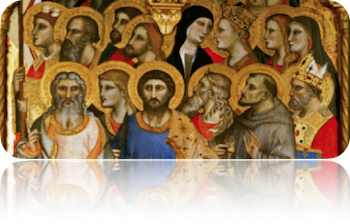Why I Believe in the “Communion of Saints”
By Ryan “Athanasius” Hicks

After some reading, I learned that “to be in communion” means to be held together in union as part of the Mystical Body of Christ. “If communion is real, then how could this shared bond end at the grave?” I asked myself. I began to explore the idea that “communion” may not end with the physical death of each believer. A few verses from the Old and New Testaments stood out to me and helped make the traditional Catholic concept of the communion of saints more appealing to my mind.
Firstly, in 2 Maccabees 15:12-13, it speaks of the High Priest of Israel blessing the soldiers, and the spirit of the (long dead) Prophet Jeremiah appearing to confer onto the troops a blessing.
“Now the vision was in this manner: Onias who had been high priest… holding up his hands, prayed for all the people of the Jews: After this there appeared also another man, admirable for age, and glory, and environed with great beauty and majesty: Then Onias answering, said: This is a lover of his brethren, and of the people of Israel: this is he that prayeth much for the people, and for all the holy city, Jeremias the prophet of God.” 2 Maccabees 15:12-13
Secondly, in St. Matthew’s Gospel, our Lord affirms that God is not a God of the dead. Thus, “And concerning the resurrection of the dead, have you not read that which was spoken by God, saying to you: I am the God of Abraham, and the God of Isaac, and the God of Jacob? He is not the God of the dead, but of the living.” Matthew 22:31-32
Thirdly, other letters in the New Testament, likewise, imply that Christians who have since passed on are still “hanging around” so-to-speak. Hence, the following:
And when the Lamb opened the fifth seal, I saw under the altar the souls of those who had been slain for the word of God and for the testimony they had upheld. And they cried out in a loud voice, “How long, O Lord, holy and true, until You judge those who live on the earth” and avenge our blood?” Revelation 6:10
With these (and other) verses in mind, I began to see that this notion of “being in communion” stretches beyond the confines of having a physical body in the here-and-now. The Catholic teachings of the “Church Militant,” “Church Penitent,” and “Church Triumphant” have a clear biblical basis.
However, it was not until I developed in interest in reading the commentaries of the saints on the Old and New Testaments that I began to see how important the saints were. From the writings of the Cappadocian Fathers (St. Basil, St. Gregory of Nyssa, St. Gregory Nazianzen) to the writings of St. Athanasius (author of “On the Incarnation”), I discovered that basically any question I had about Sacred Scripture had already been tackled by one or more of the Church Fathers. Whenever I had a question about the Bible, I would immediately Google to see if any of my favorite saints had offered their thoughts on that passage. Reading the writings of the saints has deeply enriched my faith and my understanding of Scripture. (For readers wishing to look up some saintly commentary on the New Testament, St. Thomas Aquinas organized the comments of multiple saints on each verse in his “Catena Aurea,” which can be accessed here http://www.clerus.org/bibliaclerusonline/en/jf.htm).
As I write this post, I recall that today in Rome, Oscar Romero and Pope Paul VI were canonized. The canonization of new saints is very exciting for me, because I think it helps to show how Catholicism offers a living faith which is continuously growing, not standing still. Each generation produces new saints, and these saints contribute in their own ways to the Church’s witness. For example, St. Faustina and her experiences with apparitions of Christ helped to give us the Divine Mercy Chaplet. St. Juan Diego and his experiences with the apparition of the Blessed Virgin Mary helped to convert millions of people in Mexico in a few short years. The mysticism of St. John of the Cross, St. Padre Pio, and St. Hildegaard von Bingen has provided Catholics with fresh ways of engaging with their faith. Finally, the philosophical writings of saints such as St. Augustine and St. Thomas Aquinas have provided the Church with the philosophical backbone needed to engage (and evangelize) the secular world.
Looking back on the time when I did not believe in the communion of saints, I can say with certainty that mine was barren and distorted view of the faith. Having come into the fullness of the faith, the saints remind me that I have hundreds of “older brothers” and “older sisters” who have gone before me in their walk with Christ, and who can impart precious knowledge for my further spiritual growth and development.